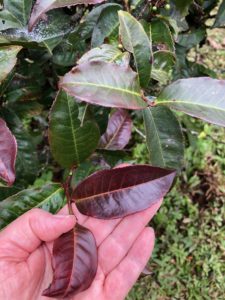What's Healthy About Tea - Introducing Purple Tea
Rewriting the book, "The Everything Healthy Tea Book" What is Purple Tea?
What is Purple Tea?
There are some naturally occurring genetic differences in our basic Camellia sinensis plant that are caused by environment (terroir) and also by genetic mutations in the plant’s chemical structure. Purple tea is one of these mutations that allow the plant to develop higher levels of the antioxidant, anthocyanin, that give the stems and leaves a reddish-purple appearance and also color the brewed liquor accordingly. The origin is debatable – between China, India and Africa. But we know that Chinese researchers were publishing studies on it’s health benefits in the 1980’s. Since then, the potential for this tea has inspired development, new production profiles and new marketing campaigns. Like our appreciation for the health benefits of dark blueberries and other dark red and blue fruits and vegetables, this leaf is of interest to those who drink tea primarily for health reasons.
What about the flavor?
“What’s the healthiest tea?” we are frequently asked. And some of my fellow tea educators will answer that it is, “… the one you drink the most.” In other words, flavor really matters.The value of enriched antioxidants is one thing. But what does the brewed taste like in your cup? In the case of this tea, the flavor has not been its most prominent feature. But one reason for that could be the simple fact that its still rather new to come into common public usage. Another factor is that most Purple Tea available in distribution has been processed as a green tea and tends toward astringency.

Tea Leaf Bouquet

Front of purple tea leaf

Back of purple tea leaf
Are Purple Tea leaves only processed as Green Tea?
No! Purple Tea is being processed as a white tea, black tea and also as a dark tea (aged and even compressed.

Purple Tea leaves processed as White Tea

Purple Tea leaves processed as Black Tea

Purple Tea leaves processed as Dark Tea
As you can see in this close-up of Purple Tea processed as a Black Tea, the leaves are very dark and almost shiny. It is the oxidizing of the leaf during this process that adds a little more sweetness to the brewed tea (more than the Green or White). And, with the additional fermentation and aging of the Dark Tea, the brewed tea flavor tends to be smoother.
But, because, in terms of international tea distribution, there is still not a a great awareness of Purple Tea and therefore, not enough demand for local retailers to stock it in their inventory. And that economic relationship from “field-to-cup”. There are hundreds (maybe thousands) of creative, cutting-edge practices happening in the tea world. Most of us are only privy to a small proportion of this work.
How Should We Categorize Purple Tea?
As many of us discuss the way in which we will introduce this tea to new marketplaces and new tea sippers, there is a debate about whether or not Purple Tea should be it’s own category. Or if it should be displayed in the existing categories (White, Green, Yellow, Oolong, Black, Dark) based on the way in which it was processed.
What would be most informative? What would be most confusing?
So, fellow Sippers, be on the lookout for this newcomer. Allow yourself an adventure in taste.
